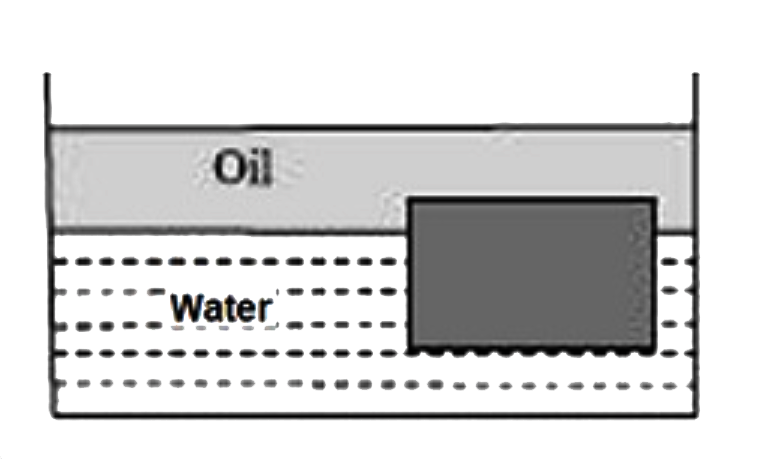A duck is floating on a lake with 25 % of its volume beneath the water . What is the average density of the duck ?
The correct Answer is:D
To find the average density of the duck that is floating on a lake with 25% of its volume submerged, we can follow these steps:
1. Understanding the Problem:
- We know that the duck is floating, which means the buoyant force acting on it is equal to its weight.
- The volume of the duck that is submerged is 25% of its total volume.
2. Define Variables:
- Let V be the total volume of the duck.
- The volume submerged in water is 25100V=V4.
3. Buoyant Force Calculation:
- The buoyant force FB can be expressed as:
FB=Vsubmerged⋅ρwater⋅g
- Here, Vsubmerged=V4, ρwater is the density of water (approximately 1000kg/m3), and g is the acceleration due to gravity.
4. Weight of the Duck:
- The weight of the duck W is given by:
W=m⋅g
- Here, m is the mass of the duck.
5. Equating Buoyant Force and Weight:
- Since the duck is floating, we have:
FB=W
- Substituting the expressions for buoyant force and weight:
V4⋅ρwater⋅g=m⋅g
- We can cancel g from both sides:
V4⋅ρwater=m
6. Density of the Duck:
- The density of the duck ρduck is defined as:
ρduck=mV
- Substituting m from the previous equation:
ρduck=V4⋅ρwaterV
- Simplifying this gives:
ρduck=ρwater4
7. Calculating the Average Density:
- Substituting the density of water:
ρduck=1000kg/m34=250kg/m3
Final Answer:
The average density of the duck is 250kg/m3.
---
- We know that the duck is floating, which means the buoyant force acting on it is equal to its weight.
- The volume of the duck that is submerged is 25% of its total volume.
- Let V be the total volume of the duck.
- The volume submerged in water is 25100V=V4.
- The buoyant force FB can be expressed as:
FB=Vsubmerged⋅ρwater⋅g
- Here, Vsubmerged=V4, ρwater is the density of water (approximately 1000kg/m3), and g is the acceleration due to gravity.
- The weight of the duck W is given by:
W=m⋅g
- Here, m is the mass of the duck.
- Since the duck is floating, we have:
FB=W
- Substituting the expressions for buoyant force and weight:
V4⋅ρwater⋅g=m⋅g
- We can cancel g from both sides:
V4⋅ρwater=m
- The density of the duck ρduck is defined as:
ρduck=mV
- Substituting m from the previous equation:
ρduck=V4⋅ρwaterV
- Simplifying this gives:
ρduck=ρwater4
- Substituting the density of water:
ρduck=1000kg/m34=250kg/m3
The average density of the duck is 250kg/m3.
Topper's Solved these Questions
- BOOK - RESNICK AND HALLIDAYCHAPTER - FLUIDSEXERCISE - PRACTICE QUESTIONS (More than One Correct Choice Type )10videos
FLUIDS
- BOOK - RESNICK AND HALLIDAYCHAPTER - FLUIDSEXERCISE - PRACTICE QUESTIONS (Linked Comprehension )9videos
FLUIDS
- BOOK - RESNICK AND HALLIDAYCHAPTER - FLUIDSEXERCISE - PROBLEMS68videos
FLUIDS
- BOOK - RESNICK AND HALLIDAYCHAPTER - ELECTROMAGNETIC WAVES EXERCISE - PRACTICE QUESTIONS (Integer Type)3videos
ELECTROMAGNETIC WAVES
- BOOK - RESNICK AND HALLIDAYCHAPTER - FORCE AND MOTION - I EXERCISE - PRACTICE QUESTIONS (Integer Type)3videos
FORCE AND MOTION - I
Similar Questions
Knowledge Check
- Question 1 - Select One
Two solids A and B float in water. It is observed that A floats with 12 of its body immersed in water and B floats with 14 of its volume above the water level. The ratio of the density of A to that of B is
A4:3B2:3C3:4D1:2 - Question 2 - Select One
A cubical block of side 0.5 m floats on water with 30% of its volume under water. What is the maximum weight that can be put on the block without fully submerging it under water?
[Take, density of water =103kg/m3]A87.5 kgB30.1 kgC46.3 kgD65.4 kg - Question 3 - Select One
A block of wood floats with 1//4 of its volume under water. What is he density of wood? (Density of water =1000kg/m3)
A750kg/m3B250kg/m3C300kg/m3D260kg/m3
A solid of density 2.5 kg m−3 floats in a fluid with one-third of its volume immersed in it. What is the density of the fluid?
View SolutionA solid floats in water with 3/4 of its volume below the surface of water. Calculate the density of the solid.
View SolutionA solid floats with (1/4)th of its volume above the surface of water. Calculate the density of the solid.
View SolutionA cubic body floats on mercury with 0.25 fraction of its volume below the surface. What fraction of the volume of the body will be immeresed in the mercury if a layer of water poured on top of the mercury covers the body conpletely.
View SolutionA layer of oil with density 724 kg m−3 floats on water of density 1000kgm−3. A block floats on the oil-water interface with 1/6 of its volume in oil and 5/6 of its volume in water, as shown in the figure. What is the density of the block?
 View Solution
View Solution

